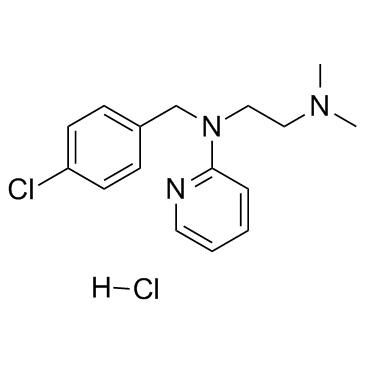
Chloropyramine hydrochloride
CAS No. 6170-42-9
Chloropyramine hydrochloride( Alergosan, Allergan S hydrochloride, Chloropyramine hydrochloride, Halopyramine hydrochloride, Nilfan, Sinopen, Suprastin )
Catalog No. M15332 CAS No. 6170-42-9
Chloropyramine is a first generation antihistamine drug approved in some Eastern European countries for the treatment of allergic conjunctivitis, allergic rhinitis, bronchial asthma, and other atopic (allergic) conditions.
Purity : >98% (HPLC)
 COA
COA
 Datasheet
Datasheet
 HNMR
HNMR
 HPLC
HPLC
 MSDS
MSDS
 Handing Instructions
Handing Instructions
| Size | Price / USD | Stock | Quantity |
| 25MG | 30 | In Stock |


|
| 50MG | 42 | In Stock |


|
| 100MG | 61 | In Stock |


|
| 200MG | 87 | In Stock |


|
| 500MG | Get Quote | In Stock |


|
| 1G | Get Quote | In Stock |


|
Biological Information
-
Product NameChloropyramine hydrochloride
-
NoteResearch use only, not for human use.
-
Brief DescriptionChloropyramine is a first generation antihistamine drug approved in some Eastern European countries for the treatment of allergic conjunctivitis, allergic rhinitis, bronchial asthma, and other atopic (allergic) conditions.
-
DescriptionChloropyramine is a first generation antihistamine drug approved in some Eastern European countries for the treatment of allergic conjunctivitis, allergic rhinitis, bronchial asthma, and other atopic (allergic) conditions. Related indications for clinical use include Quincke’s edema, allergic reactions to insect bites, food and drug allergies, and anaphylactic shock.(In Vitro):BT474 cells are highly sensitive to Chloropyramine hydrochloride (compound 1) treatment, whereby 1 μM concentrations cause a 40% reduction of viability after 48 h of treatment. It is found that at 1 μM concentrations of Chloropyramine hydrochloride, viability of control MCF7-pcDNA3 cells is significantly higher than the viability of MCF7-VEGFR-3 cells (P<0.01) and at 10 μM concentration this difference reaches twofold (P<0.001). In the BT474 cells treatment with Chloropyramine hydrochloride also leads to a concentration-dependent decrease of cell proliferation. When treatment with Chloropyramine hydrochloride is continued for 48 h, the breast cancer cells that overexpressed VEGFR-3 undergo apoptosis. This effect is dose-dependent, with 10 μM Chloropyramine hydrochloride inducing apoptosis in more than 60% of BT474 cells. In our model cell lines MCF7-pcDNA3 and MCF7-VEGFR-3, treatment with 10 μM Chloropyramine hydrochloride for 48 h leads to a 4-fold increase in apoptotic cell death in the cell line that overexpressed VEGFR-3 (18% versus 76 % respectively). (In Vivo):Chloropyramine hydrochloride causes a dramatic reduction of tumor growth in both model systems whereby the tumor size in the treated groups is approximately 20% of the tumor size in vehicle control groups. Doxorubicin administered at 3 mg/kg causes approximately 60% reduction of tumor growth, but has no effect on tumor growth at 0, 3 mg/kg. In contrast, there is a modest effect of Chloropyramine hydrochloride alone (50% reduction of tumor growth). The low-dose combination of Chloropyramine hydrochloride and doxorubicin has a prolonged anti-tumor effect (85% reduction of tumor growth) that is greater than either drug alone.
-
In VitroBT474 cells are highly sensitive to Chloropyramine hydrochloride (compound 1) treatment, whereby 1 μM concentrations cause a 40% reduction of viability after 48 h of treatment. It is found that at 1 μM concentrations of Chloropyramine hydrochloride, viability of control MCF7-pcDNA3 cells is significantly higher than the viability of MCF7-VEGFR-3 cells (P<0.01) and at 10 μM concentration this difference reaches twofold (P<0.001). In the BT474 cells treatment with Chloropyramine hydrochloride also leads to a concentration-dependent decrease of cell proliferation. When treatment with Chloropyramine hydrochloride is continued for 48 h, the breast cancer cells that overexpressed VEGFR-3 undergo apoptosis. This effect is dose-dependent, with 10 μM Chloropyramine hydrochloride inducing apoptosis in more than 60% of BT474 cells. In our model cell lines MCF7-pcDNA3 and MCF7-VEGFR-3, treatment with 10 μM Chloropyramine hydrochloride for 48 h leads to a 4-fold increase in apoptotic cell death in the cell line that overexpressed VEGFR-3 (18% versus 76 % respectively).
-
In VivoChloropyramine hydrochloride causes a dramatic reduction of tumor growth in both model systems whereby the tumor size in the treated groups is approximately 20% of the tumor size in vehicle control groups. Doxorubicin administered at 3 mg/kg causes approximately 60% reduction of tumor growth, but has no effect on tumor growth at 0, 3 mg/kg. In contrast, there is a modest effect of Chloropyramine hydrochloride alone (50% reduction of tumor growth). The low-dose combination of Chloropyramine hydrochloride and doxorubicin has a prolonged anti-tumor effect (85% reduction of tumor growth) that is greater than either drug alone.
-
SynonymsAlergosan, Allergan S hydrochloride, Chloropyramine hydrochloride, Halopyramine hydrochloride, Nilfan, Sinopen, Suprastin
-
PathwayTyrosine Kinase
-
TargetFAK
-
RecptorFAK-VEGFR-3| H1 receptor
-
Research Area——
-
Indication——
Chemical Information
-
CAS Number6170-42-9
-
Formula Weight326.26
-
Molecular FormulaC16H20ClN3·HCl
-
Purity>98% (HPLC)
-
SolubilityDMSO: 10 mM
-
SMILESN(c1ncccc1)(Cc1ccc(cc1)Cl)CCN(C)C.Cl
-
Chemical Name1,2-Ethanediamine, N-((4-chlorophenyl)methyl)-N',N'-dimethyl-N-2-pyridinyl-, monohydrochloride (9CI)
Shipping & Storage Information
-
Storage(-20℃)
-
ShippingWith Ice Pack
-
Stability≥ 2 years
Reference
1.Budihna M, et al. Pflugers Arch. 1996;431(6 Suppl 2):R217-8.
molnova catalog



related products
-
PF 573228
PF-573228 is an ATP-competitive inhibitor of FAK with IC50 of 4 nM in a cell-free assay, ~50- to 250-fold selective for FAK than Pyk2, CDK1/7 and GSK-3β.
-
Chloropyramine hydro...
Chloropyramine is a first generation antihistamine drug approved in some Eastern European countries for the treatment of allergic conjunctivitis, allergic rhinitis, bronchial asthma, and other atopic (allergic) conditions.
-
PND-1186
PND-1186 (VS-4718) is a reversible and selective FAK inhibitor with IC50 of 1.5 nM. Phase 1.



 Cart
Cart
 sales@molnova.com
sales@molnova.com


